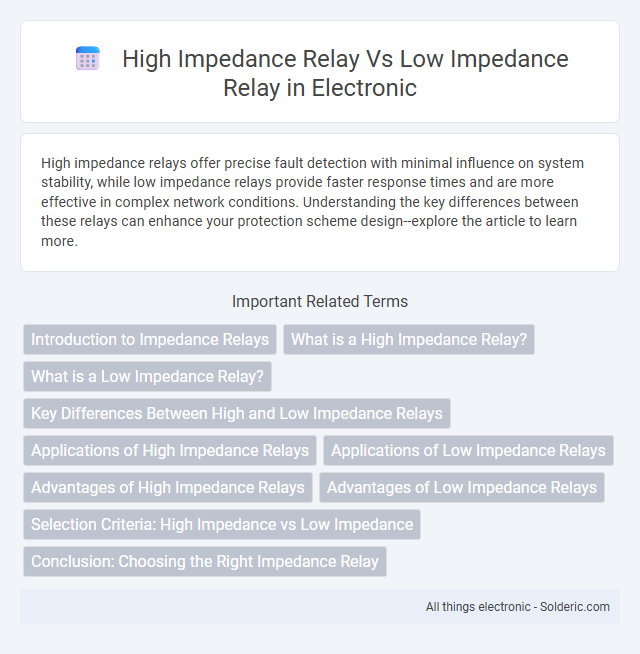High impedance relays offer precise fault detection with minimal influence on system stability, while low impedance relays provide faster response times and are more effective in complex network conditions. Understanding the key differences between these relays can enhance your protection scheme design--explore the article to learn more.
Comparison Table
| Feature | High Impedance Relay | Low Impedance Relay |
|---|---|---|
| Operating Principle | Uses a high impedance coil and resistors to measure current indirectly | Direct low impedance coil measuring current flow |
| Sensitivity | High sensitivity to fault currents | Lower sensitivity compared to high impedance |
| Fault Detection | Effective for detecting low magnitude earth faults | Designed for high magnitude fault detection |
| Coordination | Better selectivity and coordination with other relays | Less selective, possible nuisance tripping |
| Complexity | More complex wiring and settings | Simpler design and easier to maintain |
| Typical Use | Protection in distribution systems and neutral earthing | Protection in transmission lines and power transformers |
| Cost | Higher cost due to complexity | Generally lower cost |
| Example | AREVA, ABB High Impedance Earth Fault Relays | Siemens, Schneider Low Impedance Overcurrent Relays |
Introduction to Impedance Relays
Impedance relays are protective devices used in power systems to detect faults by measuring the impedance between the relay location and the fault point. High impedance relays operate by maintaining a high-impedance path, ensuring stability during external faults and minimizing false tripping, making them suitable for distance protection schemes. Low impedance relays utilize a low impedance path for faster fault detection and are often preferred for their sensitivity and accuracy in short-circuit protection.
What is a High Impedance Relay?
A high impedance relay is a protective device used in electrical power systems to detect faults by monitoring current through a high resistance path, ensuring minimal current flow during normal operation. It operates by maintaining a high impedance to prevent false tripping caused by transient currents or minor faults, enhancing system stability. Understanding high impedance relay functions can help you improve fault detection accuracy and system reliability.
What is a Low Impedance Relay?
A low impedance relay is a protective relay designed to operate with a minimal internal impedance, allowing it to detect and clear faults in power systems quickly and accurately. It provides stable and reliable fault detection under various system conditions, such as high short-circuit currents and transformer inrush currents, minimizing maloperation risks. Commonly used in busbar and transformer protection schemes, low impedance relays ensure selective tripping by accurately measuring current and voltage signals with low susceptibility to external disturbances.
Key Differences Between High and Low Impedance Relays
High impedance relays feature high coil resistance, resulting in lower current draw and suitability for sensitive electronic circuits, while low impedance relays have low coil resistance, allowing faster switching and greater durability under heavy loads. High impedance relays tend to generate less electrical noise and are ideal for signal-level applications, whereas low impedance relays handle higher power applications with quicker response times. The key differences include coil resistance, current consumption, switching speed, and appropriate usage scenarios in electronic and power systems.
Applications of High Impedance Relays
High impedance relays are primarily used in protection schemes for electrical power systems, especially in detecting earth faults in transformers and generators where sensitivity to small fault currents is crucial. These relays are ideal for ground fault protection in high-resistance grounded systems because they can accurately measure high-resistance fault currents without being affected by system capacitance. Your choice of a high impedance relay ensures reliable fault detection, minimizing the risk of equipment damage and enhancing system stability.
Applications of Low Impedance Relays
Low impedance relays are primarily used in high voltage power systems for differential protection due to their ability to provide stable operation under heavy fault currents and CT saturation conditions. These relays effectively detect internal faults in transformers, generators, and busbars by utilizing a low impedance path that minimizes the influence of external disturbances and ensures rapid fault clearance. Their application enhances system reliability and minimizes equipment damage by enabling precise fault localization and selective tripping.
Advantages of High Impedance Relays
High impedance relays offer superior sensitivity and stability in detecting fault currents, making them ideal for precise protection in power systems. Their design minimizes the influence of external noise and transient conditions, enhancing reliability during fault detection. Your power network benefits from reduced false trips and improved selectivity when employing high impedance relay technology.
Advantages of Low Impedance Relays
Low impedance relays offer improved stability and accuracy in detecting faults due to their ability to minimize the impact of arc resistance and system transients. These relays provide better discrimination and selectivity by operating with a well-defined and low impedance secondary circuit, reducing errors caused by CT saturation. Enhanced sensitivity and reliability make low impedance relays advantageous in high-current and high-voltage power systems for precise fault detection and protection.
Selection Criteria: High Impedance vs Low Impedance
High impedance relays are selected for their superior sensitivity and accuracy in detecting ground faults in high-resistance grounded systems, minimizing false trips due to system noise. Low impedance relays offer faster response times and handle high fault currents effectively, making them ideal for solidly grounded or low-resistance systems. The choice depends on system grounding type, fault current levels, and the need for selectivity and reliability in relay operation.
Conclusion: Choosing the Right Impedance Relay
Choosing the right impedance relay depends on the specific protection requirements and system characteristics. High impedance relays provide stable fault detection in networks with high resistance grounding, while low impedance relays offer faster response and sensitivity in low resistance or solidly grounded systems. Understanding your system's grounding and fault current conditions ensures optimal relay selection for reliable and accurate protection.
high impedance relay vs low impedance relay Infographic

 solderic.com
solderic.com